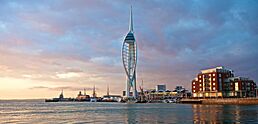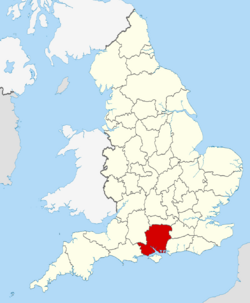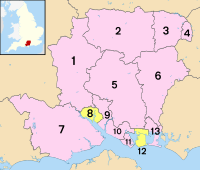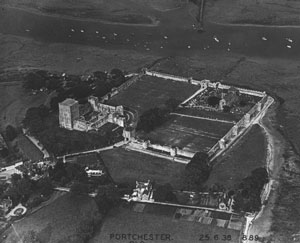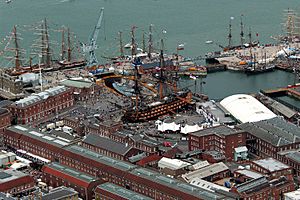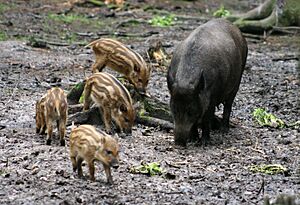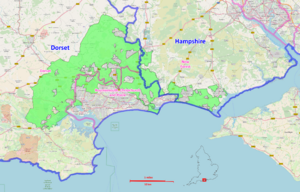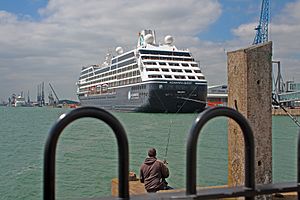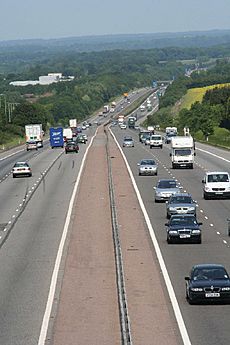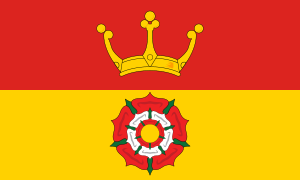Hampshire facts for kids
Quick facts for kids
Hampshire
|
|||||||||||||||||||||||||||||||||||||||||||||||||||||||||
|---|---|---|---|---|---|---|---|---|---|---|---|---|---|---|---|---|---|---|---|---|---|---|---|---|---|---|---|---|---|---|---|---|---|---|---|---|---|---|---|---|---|---|---|---|---|---|---|---|---|---|---|---|---|---|---|---|---|
|
Spinnaker Tower and Portsmouth Harbour (top), Winchester Cathedral (bottom left), and ponies in the New Forest (bottom right)
|
|||||||||||||||||||||||||||||||||||||||||||||||||||||||||
| Sovereign state | United Kingdom | ||||||||||||||||||||||||||||||||||||||||||||||||||||||||
| Constituent country | England | ||||||||||||||||||||||||||||||||||||||||||||||||||||||||
| Region | South East | ||||||||||||||||||||||||||||||||||||||||||||||||||||||||
| Established | Ancient | ||||||||||||||||||||||||||||||||||||||||||||||||||||||||
| Time zone | UTC±00:00 (Greenwich Mean Time) | ||||||||||||||||||||||||||||||||||||||||||||||||||||||||
| • Summer (DST) | UTC+01:00 (British Summer Time) | ||||||||||||||||||||||||||||||||||||||||||||||||||||||||
| Members of Parliament | List of MPs | ||||||||||||||||||||||||||||||||||||||||||||||||||||||||
| Police | Hampshire and Isle of Wight Constabulary | ||||||||||||||||||||||||||||||||||||||||||||||||||||||||
|
|||||||||||||||||||||||||||||||||||||||||||||||||||||||||
Hampshire is a county in the south-east of England. It borders Berkshire, Surrey, West Sussex, Dorset, and Wiltshire. The Isle of Wight is just across the water to the south. The biggest cities in Hampshire are Southampton and Portsmouth. The historic capital, or county town, is Winchester.
Hampshire covers about 3,769 square kilometers (1,455 square miles). It is home to over 1.8 million people. This makes it the 5th most populated county in England. The areas around Southampton and Portsmouth are very busy. Other large towns include Basingstoke, Andover, and Winchester. The middle and south-west parts of the county are mostly countryside.
The county has rolling hills. A band of chalk hills runs from the north-west to the south-east. These form the Hampshire Downs and part of the South Downs. Major rivers like the Itchen and Test start in these hills. They flow south into Southampton Water, a large natural harbor. The New Forest is in the south-west. It has ancient woodlands, open heathland, and pastures.
People have lived in Hampshire for about 14,000 years. Its recorded history began with the Romans. Back then, Winchester was an important town. In the Middle Ages, ports like Southampton grew. They became busy with trade, fishing, and shipbuilding. Hampshire also played a key role in World War One and Two. This was because of its important ports and military bases.
Contents
- What's in a Name? The Story of Hampshire
- Hampshire's Past: A Journey Through Time
- Exploring Hampshire's Landscape and Nature
- Cities and Towns in Hampshire
- People and Culture in Hampshire
- Learning in Hampshire: Schools and Universities
- Hampshire's Culture: Arts, Sports, and Events
- Famous People from Hampshire
- See also
What's in a Name? The Story of Hampshire
The name Hampshire comes from an old Saxon settlement. This settlement was called Hamtun, which is now Southampton. The area around it was known as Hamtunscīr. This means "Hamtun's shire" or "Hamtun's county."
The old name was written as "Hantescire" in the Domesday Book. This is where the short form "Hants" comes from. For a while, the county was even called "County of Southampton."
Many early English colonists left from Hampshire. They sailed to North America in the 1600s. They named a new land New Hampshire to honor their home.
Hampshire's Past: A Journey Through Time
Hampshire has a long and interesting history. People have lived here since the last Ice Age, about 12,000 BCE. Back then, Britain was connected to Europe by land. The first people were hunter-gatherers.
Ancient Times: From Stone Age to Iron Age
Around 4000 BCE, farming began in southern Britain. Forests were cleared for farms. Hampshire has few very old monuments. However, Stonehenge was built nearby. Later, in the Iron Age, people built hillforts. These were fortified settlements on hilltops. Many can still be seen today, like Danebury Rings. During this time, people spoke a Celtic language.
The Romans arrived in 43 CE. Hampshire became part of the Roman province of Britannia. Winchester was an important Roman town. Another major Roman town was Silchester. The Romans built defensive walls around towns. They also had a pottery industry in the New Forest. A fort called Clausentum helped protect the coast.
Portchester Castle was a Roman fort. It is the best-preserved Roman fort north of the Alps. A Norman castle was added later. The Romans left Britain in 410 CE.
Early English Kingdoms: Jutes and Saxons
After the Romans left, new groups arrived. The Jutes settled in Hampshire. They formed small kingdoms along rivers like the Itchen and Meon. Later, the West Saxons moved south. They took over Hampshire.
Winchester became the capital of Wessex. This kingdom grew stronger. King Alfred the Great was a famous king from Wessex. He fought off the Vikings in the 800s. He also started the Anglo-Saxon Chronicle. This book helped create an English identity.
Medieval and Modern Hampshire: Growth and Change
After the Norman Conquest of England, London became the main capital. But Winchester remained important. The New Forest was a favorite hunting ground for kings. In 1100, William Rufus was killed there.
Ports like Southampton and Portsmouth grew a lot. They traded with Europe. They also had wool, cloth, and shipbuilding industries. By the 1500s, Southampton was bigger than Winchester.
Over centuries, many castles and forts were built. They protected the harbors at Southampton and Portsmouth. These include Portchester Castle and forts built by Henry VIII. Southampton and Portsmouth remained key ports. The Mayflower sailed from Southampton to America in 1620.
During the English Civil War (1642–1651), Hampshire saw battles. Important ones included the Siege of Basing House and the Battle of Cheriton. These were big wins for the Parliamentarian side.
By the mid-1800s, farming was still important. But industries like silk, paper, and shipbuilding grew. Portsmouth was a major naval base. Southampton had busy steam docks. Many people from Southampton worked on ships. The Titanic crew was mostly from Southampton.
In 1908, the first powered flight in the UK happened in Farnborough. This was a big moment for aviation.
Hampshire in the 20th Century
Hampshire played a vital role in both World War One and Two. This was due to the Royal Navy base in Portsmouth. Also, the army camp at Aldershot was very important. Supermarine, the company that designed the Spitfire aircraft, was based in Southampton. This led to heavy bombing of the city in World War II.
The Isle of Wight used to be part of Hampshire. But it became independent in 1890. In 1974, the towns of Bournemouth and Christchurch moved to Dorset.
Exploring Hampshire's Landscape and Nature
Hampshire is the largest county in South East England. It has an area of about 3,700 square kilometers (1,400 square miles).
Hampshire's Land: Rocks and Rivers
Hampshire's land is made of two main types. The south has soft clays and gravels. These form the Hampshire Basin. This area has heathland and woodland. A large part of it is the New Forest. The New Forest has many different habitats. It is home to diverse wildlife. It is protected as a national park. This helps protect its natural beauty and animals.
The north and center of the county have chalk hills. These are the Hampshire Downs and South Downs. The highest point in Hampshire is Pilot Hill. It is 286 meters (938 feet) tall.
Hampshire's rivers are important for wildlife. The Itchen and Test are famous for trout. They also have a growing number of otters. The New Forest is known for its ponies and herds of deer. Wild boar are also found there.
Hampshire has two national parks. The New Forest National Park is entirely within the county. The South Downs National Park covers parts of Hampshire and other counties.
Hampshire's Weather: A Mild Climate
Hampshire has a milder climate than most of the UK. This is because it is in the far south. The sea also helps to keep the weather steady. Hampshire has warmer average temperatures. It also gets more sunshine than the UK average.
Cities and Towns in Hampshire
Hampshire's county town is Winchester. It is a historic city. It was once the capital of England. The port cities of Southampton and Portsmouth are very important. They are independent for local government. But they are still part of Hampshire for ceremonial events.
Other growing towns include Fareham, Gosport, and Havant. These towns stretch along the coast between Southampton and Portsmouth. All three cities have universities.
The north-east of the county has the Blackwater Valley area. This includes Farnborough, Aldershot, and Yateley. These towns are close to Berkshire and Surrey.
Hampshire has good train and motorway links to London. Many people live in Hampshire and travel to London for work. Basingstoke has grown into a big business center. Aldershot, Portsmouth, and Farnborough have strong links to the military. The county also has many smaller market towns. These include Alton, Andover, and Lymington.
People and Culture in Hampshire
Hampshire is a wealthy county. Many people work in high-tech industries. Tourism is also a big part of the economy. It creates about 60,000 jobs.
Hampshire's Population: Who Lives Here?
In 2011, Hampshire had a population of about 1.3 million people. This number has grown steadily. The largest cities are Southampton and Portsmouth. About half of the county's population lives in the area around these two cities.
Most residents in Hampshire are white British. Other groups include Asian and mixed-race people. About 10% of residents were born outside the UK. Most people in Hampshire are Christian. Some minority religions include Islam and Hinduism.
Emergency Services: Keeping People Safe
Hampshire has several important emergency services. These include:
- Hampshire and Isle of Wight Fire and Rescue Service
- South Central Ambulance Service
- Hampshire Constabulary (police force)
- HM Coastguard (for coastal safety)
Hampshire's Economy: Jobs and Industries
Hampshire is one of the richest counties in England. It has a high-tech industry. Companies like IBM have offices here. Many people work in the public sector.
Farming used to be the main industry in rural Hampshire. Now, it employs fewer people. The county also has oil and gas reserves. The New Forest is a national park. Tourism brings many visitors and jobs to this area.
Southampton and Portsmouth are major ports. Southampton Docks handles a lot of cargo. It is also a big base for cruise ships. Portsmouth Harbour is a main base for the Royal Navy. It also has ferries to France and Spain.
Getting Around: Transport in Hampshire
Hampshire has good transport links.
Travel by Air
Southampton Airport is an international airport. It is near Southampton. The Farnborough International Airshow is a huge event. It happens every two years at Farnborough Airport. It shows off new aerospace and defense technology.
Travel by Sea
Ferries connect Hampshire to the Isle of Wight. They also go to the Channel Islands and Europe. These ferries leave from Southampton, Portsmouth, and Lymington.
Travel by Train
The main train line from London to Weymouth runs through Winchester and Southampton. Other lines connect Bristol to Portsmouth.
Travel by Road
The M3 motorway goes through Hampshire. It connects to the M25 London orbital motorway. The M27 south coast motorway links towns along the coast. Hampshire has a high number of car owners. People use cars more than trains or buses for travel.
Travel by Waterways
Hampshire used to have many canals. Most are now gone. The Basingstoke Canal has been restored. It can be used for boats again.
Learning in Hampshire: Schools and Universities
Hampshire has a comprehensive school system. This means all students go to the same type of school. There are also many independent schools.
Hampshire has 14 colleges for further education. These colleges offer courses after high school. Some are very highly rated.
There are four universities in Hampshire:
- University of Southampton
- Solent University
- University of Portsmouth
- University of Winchester
Hampshire's Culture: Arts, Sports, and Events
Hampshire has a rich culture. It is known for its flag, music, museums, and sports.
Hampshire's Flag: A Symbol of Pride
The Flag of Hampshire was officially recognized in 2019. It has a red and white rose. The county day is July 15th. This is St Swithun's Day. He was an old bishop of Winchester.
Music in Hampshire: Sounds of the County
Hampshire is home to many musical groups. The Hampshire County Youth Choir is based in Winchester. The Hampshire County Youth Orchestra also performs here.
Museums in Hampshire: Exploring the Past
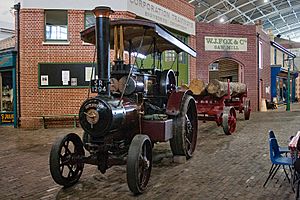
Hampshire has many local museums. The City Museum in Winchester covers history from the Iron Age to Victorian times. The Solent Sky Museum shows the history of aviation in the area. Southampton's Sea City Museum focuses on the city's link to the Titanic. Milestones Museum in Basingstoke shows the county's industrial past.
There are also national museums. The National Motor Museum is in the New Forest. The Royal Navy Museum is part of Portsmouth Historic Dockyard. Other military museums include the Submarine Museum and the Museum of Army Flying.
Annual Events: Fun Throughout the Year
The New Forest and Hampshire County Show happens every July. It is a big event. The Jalsa Salana, a large gathering of Muslims, takes place near Alton. The ancient festival of Beltain is celebrated at Butser Ancient Farm in spring.
Buildings and Monuments: Historic Places to See
Hampshire has many historic buildings. There are 187 Grade I listed buildings. These include churches, castles, and farm buildings. There are also many scheduled monuments. The Battle of Cheriton battlefield is also a protected site.
Sports in Hampshire: From Cricket to Football
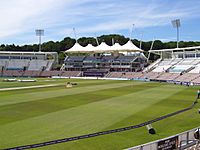
Cricket was developed in south-east England. The Hambledon Club helped create many early cricket rules. Hampshire County Cricket Club is a professional team. They play at the Ageas Bowl.
The world's oldest surviving bowling green is in Southampton. It was first used in 1299.
Hampshire's calm waters make it popular for sailing. Many yacht clubs are on the Solent. Windsurfing was invented at Hayling Island.
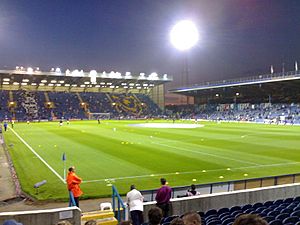
Hampshire has several football teams. These include Premier League side Southampton and EFL Championship side Portsmouth. Portsmouth and Southampton are big rivals. Portsmouth won the FA Cup in 1939 and 2008. Southampton won the FA Cup in 1976.
Thruxton Circuit is Hampshire's main motor racing track. It also has a karting circuit. Lasham Airfield is a major center for gliding.
Media in Hampshire: News and Entertainment
Television
Hampshire's TV news is covered by BBC South Today and ITV Meridian.
Radio
Local radio stations include BBC Radio Solent. There are also commercial stations like Heart South. Many community radio stations serve local areas.
Newspapers
Southampton has the Southern Daily Echo. Portsmouth has The News. The Hampshire Chronicle is one of the oldest newspapers in the country.
Famous People from Hampshire
Many notable people have lived in Hampshire.
- The Duke of Wellington lived at Stratfield Saye House.
- Florence Nightingale, a famous nurse, is buried in Hampshire.
- Authors like Jane Austen, Wilbert Awdry, and Charles Dickens were born here. Jane Austen wrote all her novels in Hampshire.
- Alice Liddell, who inspired Alice's Adventures in Wonderland, lived in Lyndhurst, Hampshire.
- Painters like John Everett Millais are from Hampshire.
- Journalist Christopher Hitchens was born in Portsmouth.
- Broadcasters Philippa Forrester, Amanda Lamb, and Scott Mills are also from the county.
See also
 In Spanish: Hampshire para niños
In Spanish: Hampshire para niños


